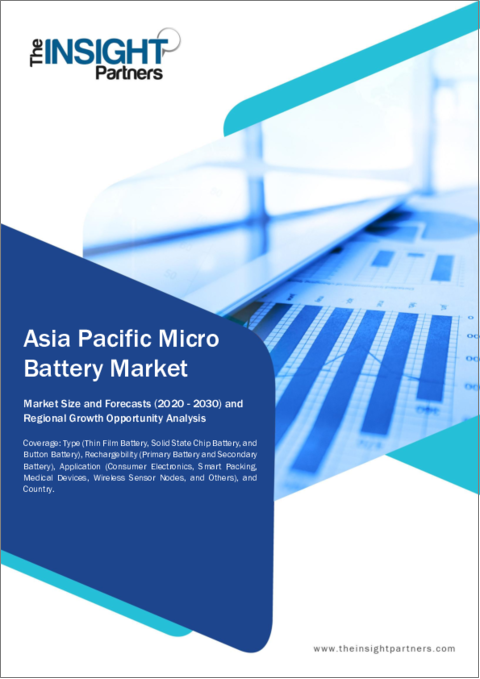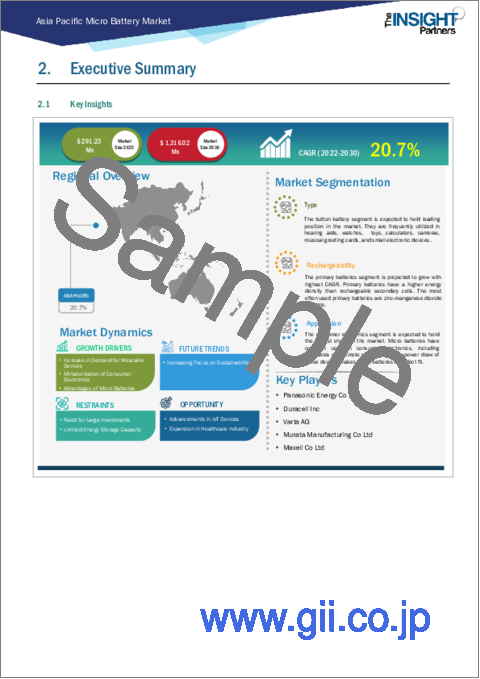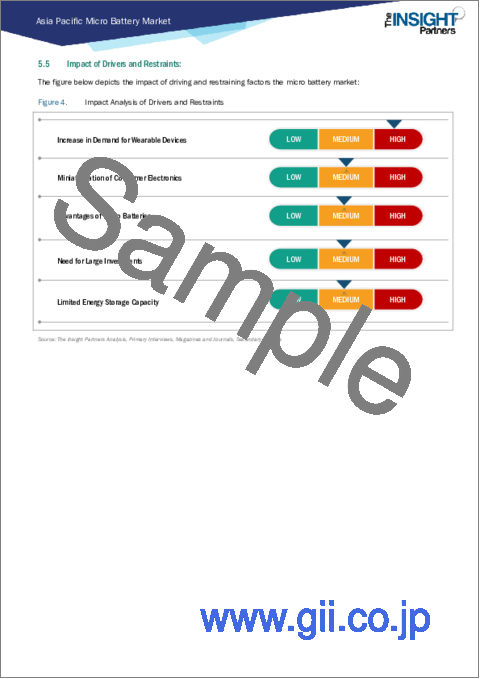|
|
市場調査レポート
商品コード
1562342
アジア太平洋地域のマイクロバッテリー:2030年市場予測- 地域別分析- タイプ別、再充電可能性別、用途別Asia Pacific Micro Battery Market Forecast to 2030 - Regional Analysis - by Type, Rechargeability, and Application |
||||||
|
|||||||
| アジア太平洋地域のマイクロバッテリー:2030年市場予測- 地域別分析- タイプ別、再充電可能性別、用途別 |
|
出版日: 2024年07月04日
発行: The Insight Partners
ページ情報: 英文 83 Pages
納期: 即納可能
|
全表示
- 概要
- 図表
- 目次
アジア太平洋のマイクロバッテリー市場は、2022年に2億9,123万米ドルと評価され、2030年には13億1,602万米ドルに達すると予測され、2022~2030年のCAGRは20.7%を記録すると予測されています。
IoT機器の進歩がアジア太平洋のマイクロバッテリー市場を押し上げる
モノのインターネット(IoT)は、機器間のシームレスな接続を可能にし、スマート機器の広大なエコシステムを構築することで、技術との関わり方に革命をもたらしました。さまざまな産業やセグメントでIoT機器が増え続ける中、信頼性が高く効率的な電源の必要性が極めて重要になっています。これは、マイクロバッテリー市場がIoT機器の電力需要を満たす上で重要な役割を果たす大きな機会となります。IoTの業界情勢は指数関数的に拡大しており、スマートホーム、産業オートメーション、医療、輸送などの多様な用途を包含しています。これらのIoT機器は小型化された電子機器に依存しており、コンパクトで長寿命の電力ソリューションが必要です。小型で高いエネルギー密度を持つマイクロバッテリーは、IoT機器の要件に完全に合致しており、理想的な電源となっています。さらに、IoT機器は遠隔地や手の届きにくい場所で動作することが多く、機能を中断させないためには信頼性の高い電源が必要です。マイクロバッテリーは、このような厳しい環境でも簡単に導入でき、ポータブルで自己完結型の電源ソリューションを記載しています。この柔軟性により、IoT機器は、農地でのスマートセンサーから医療環境でのバイタルサインを監視するウェアラブルまで、さまざまなシナリオで展開することができます。さらに、IoT機器の進化とマイクロバッテリー技術の進化が相まって、ユーザー体験が向上しています。これはエンドユーザーの利便性、寿命、信頼性の向上につながり、日常のさまざまな場面でのIoT技術のさらなる採用と統合を促進しています。
アジア太平洋のマイクロバッテリー市場概要
アジア太平洋のさまざまな国々では、モノのインターネット(IoT)の統合や医療システムの進歩など、スマートシティのプロジェクトに重点が置かれ、技術的に先進的な状況へとダイナミックに変化しています。また、消費者の間でスマート民生用電子機器やウェアラブルガジェットに及ぶコネクテッド機器が急増していることも、アジア太平洋におけるマイクロバッテリー市場の成長を後押ししています。さらに、これらの機器は薄型で柔軟性があり、安全な電源を必要とするが、マイクロバッテリーはこれを提供できます。さらに、アジア諸国では、スマートフォン、タブレット、ウェアラブル機器など、その他の消費者向け電子機器の需要が拡大していることも、今後数年間のアジア太平洋のマイクロバッテリー市場の成長を後押しします。アジア太平洋では、中国が消費者向け電子機器の最大の製造国です。Nikkei Inc.によると、中国政府は2023年まで3,270億米ドルを投資し、国内の電子機器市場を拡大するためのさまざまな計画に取り組んでいます。さらに、インド政府も国内の電子機器市場を拡大しようとしています。電子情報技術省(Ministry of Electronics &IT)によると、インド政府のイニシアティブと業界の努力により、電子製品の国内生産は2020年に747億米ドルの収益を上げ、CAGRは17.9%となっています。エレクトロニクス製造に対する政府の政策には、生産連動奨励金(PLI)スキーム、電子部品・半導体製造促進スキーム(SPECS)、修正エレクトロニクス製造クラスター(EMC 2.0)スキームなどがあります。さらに、アジア太平洋のエレクトロニクス部門は、アジアの総輸出額の20~50%を占めています。アジア太平洋は最大の電子機器メーカーであるため、予測期間中、同地域全体で超小型電池の需要が高まると考えられます。さらに、ワイヤレス体温計、パルスオキシメーター、ドラッグデリバリーパッチなど、特にCOVID-19患者の治療中に使用される医療機器でのマイクロバッテリーの使用が増加しています。
アジア太平洋のマイクロバッテリー市場の収益と2030年までの予測(金額)
アジア太平洋のマイクロバッテリー市場セグメンテーション
アジア太平洋のマイクロバッテリー市場は、タイプ、再充電可能性、用途、国によって区分されます。タイプ別では、アジア太平洋のマイクロバッテリー市場は薄膜電池、固体チップ電池、ボタン電池に分類されます。2022年には、ボタン電池セグメントが最大の市場シェアを占めています。
再充電可能性別では、アジア太平洋のマイクロバッテリー市場は一次電池と二次電池に二分されます。一次電池セグメントが2022年に大きな市場シェアを占めました。
用途別では、アジア太平洋のマイクロバッテリー市場は民生用電子機器、スマートパッキング、医療機器、ワイヤレスセンサーノード、その他に分類されます。民生用電子機器セグメントが2022年に最大の市場を占めました。
国別では、アジア太平洋マイクロバッテリー市場は、オーストラリア、中国、日本、インド、韓国、その他のアジア太平洋に区分されます。2022年のアジア太平洋マイクロバッテリー市場シェアは中国が独占しています。
Molex LLC、Murata Manufacturing Co Ltd、Varta AG、Duracell Inc、Renata SA、Maxell Holdings Ltd、Seiko Instruments Inc、Panasonic Energy Co Ltdは、アジア太平洋のマイクロバッテリー市場で事業を展開している主要企業です。
目次
第1章 イントロダクション
第2章 エグゼクティブサマリー
- 主要洞察
- 市場の魅力
第3章 調査手法
- 調査範囲
- 2次調査
- 1次調査
第4章 アジア太平洋のマイクロバッテリー市場情勢
- イントロダクション
- エコシステム分析
- バリューチェーンのベンダー一覧
第5章 アジア太平洋のマイクロバッテリー市場:主要産業力学
- 促進要因
- ウェアラブル機器需要の増加
- 民生用電子機器製品の小型化
- マイクロバッテリーの利点
- 抑制要因
- 多額の投資が必要
- エネルギー貯蔵容量の限界
- 機会
- IoT機器の進歩
- 医療産業の拡大
- 動向
- 持続可能性への注目の高まり
- 促進要因と抑制要因の影響
第6章 マイクロバッテリー市場:アジア太平洋市場分析
- マイクロバッテリー市場概要
- マイクロバッテリー市場の収益(2020~2030年)
- マイクロバッテリー市場の予測と分析
第7章 アジア太平洋のマイクロバッテリー市場分析:タイプ別
- ボタン電池
- ボタン電池市場の収益と2030年までの予測
- 薄膜電池
- 薄膜電池概要
- 薄膜電池市場の収益と2030年までの予測
- 固体チップ電池
- 固体チップ電池概要
- 固体チップ電池市場の収益と2030年までの予測
第8章 アジア太平洋のマイクロバッテリー市場分析:再充電可能性別
- 一次電池
- 一次電池概要
- 一次電池市場の収益と2030年までの予測
- 二次電池
- 二次電池概要
- 二次電池市場の収益と2030年までの予測
第9章 アジア太平洋のマイクロバッテリー市場分析:用途別
- コンシューマーエレクトロニクス
- コンシューマーエレクトロニクス市場の収益と2030年までの予測
- 医療機器
- 医療機器市場の収益と2030年までの予測
- スマートパッキング
- スマートパッキング市場の収益と2030年までの予測
- 無線センサーノード
- 無線センサーノード市場の収益と2030年までの予測
- その他
- その他概要
- その他市場の収益と2030年までの予測
第10章 アジア太平洋のマイクロバッテリー市場:国別分析
- オーストラリア
- 中国
- インド
- 日本
- 韓国
- その他のアジア太平洋
第11章 競合情勢
- 主要参入企業別ヒートマップ分析
第12章 業界情勢
- イントロダクション
- 市場イニシアティブ
- 新製品開発
第13章 企業プロファイル
- Molex LLC
- Murata Manufacturing Co Ltd
- Varta AG
- Duracell Inc
- RENATA SA
- Maxell Holdings, Ltd
- Seiko Instruments Inc
- Panasonic Energy Co Ltd
第14章 付録
List Of Tables
- Table 1. Micro Battery Market Segmentation
- Table 2. Micro Battery Market Revenue and Forecasts to 2030 (US$ Million)
- Table 3. Micro Battery Market Revenue and Forecasts to 2030 (US$ Million) - Type
- Table 4. Micro Battery Market Revenue and Forecasts to 2030 (US$ Million) - Rechargeability
- Table 5. Micro Battery Market Revenue and Forecasts to 2030 (US$ Million) - Application
- Table 6. Asia Pacific Micro Battery Market, by Country - Revenue and Forecast to 2030 (USD Million)
- Table 7. Australia Micro Battery Market Revenue and Forecasts to 2030 (US$ Mn) - By Type
- Table 8. Australia Micro Battery Market Revenue and Forecasts to 2030 (US$ Mn) - By Rechargeability
- Table 9. Australia Micro Battery Market Revenue and Forecasts to 2030 (US$ Mn) - By Application
- Table 10. China Micro Battery Market Revenue and Forecasts to 2030 (US$ Mn) - By Type
- Table 11. China Micro Battery Market Revenue and Forecasts to 2030 (US$ Mn) - By Rechargeability
- Table 12. China Micro Battery Market Revenue and Forecasts to 2030 (US$ Mn) - By Application
- Table 13. India Micro Battery Market Revenue and Forecasts to 2030 (US$ Mn) - By Type
- Table 14. India Micro Battery Market Revenue and Forecasts to 2030 (US$ Mn) - By Rechargeability
- Table 15. India Micro Battery Market Revenue and Forecasts to 2030 (US$ Mn) - By Application
- Table 16. Japan Micro Battery Market Revenue and Forecasts to 2030 (US$ Mn) - By Type
- Table 17. Japan Micro Battery Market Revenue and Forecasts to 2030 (US$ Mn) - By Rechargeability
- Table 18. Japan Micro Battery Market Revenue and Forecasts to 2030 (US$ Mn) - By Application
- Table 19. South Korea Micro Battery Market Revenue and Forecasts to 2030 (US$ Mn) - By Type
- Table 20. South Korea Micro Battery Market Revenue and Forecasts to 2030 (US$ Mn) - By Rechargeability
- Table 21. South Korea Micro Battery Market Revenue and Forecasts to 2030 (US$ Mn) - By Application
- Table 22. Rest of Asia Pacific Micro Battery Market Revenue and Forecasts to 2030 (US$ Mn) - By Type
- Table 23. Rest of Asia Pacific Micro Battery Market Revenue and Forecasts to 2030 (US$ Mn) - By Rechargeability
- Table 24. Rest of Asia Pacific Micro Battery Market Revenue and Forecasts to 2030 (US$ Mn) - By Application
- Table 25. Company Positioning & Concentration
- Table 26. List of Abbreviation
List Of Figures
- Figure 1. Micro Battery Market Segmentation, By Country
- Figure 2. Ecosystem: Micro Battery Market
- Figure 3. Micro Battery Market - Key Industry Dynamics
- Figure 4. Impact Analysis of Drivers and Restraints
- Figure 5. Micro Battery Market Revenue (US$ Million), 2022 & 2030
- Figure 6. Micro Battery Market Share (%) - Type, 2022 and 2030
- Figure 7. Button Battery Market Revenue and Forecasts to 2030 (US$ Million)
- Figure 8. Thin Film Battery Market Revenue and Forecasts to 2030 (US$ Million)
- Figure 9. Solid State Chip Battery Market Revenue and Forecasts To 2030 (US$ Million)
- Figure 10. Micro Battery Market Share (%) - Rechargeability, 2022 and 2030
- Figure 11. Primary Battery Market Revenue and Forecasts to 2030 (US$ Million)
- Figure 12. Secondary Battery Market Revenue and Forecasts to 2030 (US$ Million)
- Figure 13. Micro Battery Market Share (%) - Application, 2022 and 2030
- Figure 14. Consumer Electronics Market Revenue and Forecasts to 2030 (US$ Million)
- Figure 15. Medical Devices Market Revenue and Forecasts to 2030 (US$ Million)
- Figure 16. Smart Packing Market Revenue and Forecasts to 2030 (US$ Million)
- Figure 17. Wireless Sensor Nodes Market Revenue and Forecasts to 2030 (US$ Million)
- Figure 18. Others Market Revenue and Forecasts to 2030 (US$ Million)
- Figure 19. Asia Pacific Micro Battery Market Revenue, By Key Country, (2022) (US$ Million)
- Figure 20. Asia Pacific Micro Battery Market Breakdown By Key Countries, 2022 and 2030 (%)
- Figure 21. Australia Micro Battery Market Revenue and Forecasts to 2030 (US$ Mn)
- Figure 22. China Micro Battery Market Revenue and Forecasts to 2030 (US$ Mn)
- Figure 23. India Micro Battery Market Revenue and Forecasts to 2030 (US$ Mn)
- Figure 24. Japan Micro Battery Market Revenue and Forecasts to 2030 (US$ Mn)
- Figure 25. South Korea Micro Battery Market Revenue and Forecasts to 2030 (US$ Mn)
- Figure 26. Rest of Asia Pacific Micro Battery Market Revenue and Forecasts to 2030 (US$ Mn)
The Asia Pacific micro battery market was valued at US$ 291.23 million in 2022 and is expected to reach US$ 1,316.02 million by 2030; it is estimated to record a CAGR of 20.7% from 2022 to 2030.
Advancements in IoT Devices Boost Asia Pacific Micro Battery Market
The Internet of Things (IoT) has revolutionized how we interact with technology, enabling seamless connectivity between devices and creating a vast ecosystem of smart devices. As IoT devices continue to increase across various industries and sectors, the need for reliable and efficient power sources becomes crucial. This presents a significant opportunity for the micro battery market to play a vital role in meeting the power demands of IoT devices. The IoT landscape has expanded exponentially, encompassing diverse applications such as smart homes, industrial automation, healthcare, transportation, and more. These IoT devices rely on miniaturized electronics that require compact and long-lasting power solutions. Micro batteries, with their small form factor and high energy density, perfectly align with the requirements of IoT devices, making them an ideal power source. Moreover, IoT devices often operate in remote or hard-to-reach locations, requiring reliable power sources to ensure uninterrupted functionality. Micro batteries are easily deployable in these challenging environments, providing a portable, self-contained power solution. This flexibility allows IoT devices to be deployed in various scenarios, from smart sensors in agricultural fields to wearables monitoring vital signs in healthcare settings. Additionally, the advancements in IoT devices, coupled with the evolution of micro battery technology, have led to enhanced user experiences. This translates to improved convenience, longevity, and reliability for end users, fostering further adoption and integration of IoT technology in various aspects of daily.
Asia Pacific Micro Battery Market Overview
Various countries in the Asia Pacific region are experiencing a dynamic shift toward the technologically advanced landscape with a key emphasis on projects in smart cities, such as the integration of the Internet of Things (IoT) and advancements of healthcare systems. The surge in connected devices, spanning smart home appliances and wearable gadgets among consumers, is also propelling the micro battery market growth in Asia Pacific. Moreover, these devices require thin, flexible, and safe power sources, which micro batteries can provide. In addition, the growing demand for other consumer electronic devices such as smartphones, tablets, wearables, and other devices in Asian countries will also boost the growth of the Asia Pacific micro battery market in the coming years. In Asia Pacific, China is the largest manufacturer of consumer electronic devices. According to Nikkei Inc., the Chinese government is working on various plans to expand the country's domestic electronic market by investing US$ 327 billion till 2023. In addition, the Indian government is expanding the electronics market in the country. According to the Ministry of Electronics & IT, initiatives by the Indian government and efforts of the industry have led to the domestic production of electronic goods with revenue of US$ 74.7 billion in 2020 and a CAGR of 17.9%. A few government policies for electronics manufacturing include the Production Linked Incentive (PLI) Schemes, the Scheme for Promotion of Manufacturing of Electronic Components and Semiconductors (SPECS), and the Modified Electronics Manufacturing Cluster (EMC 2.0) Scheme. Furthermore, the electronics sector in Asia Pacific accounts for 20-50% of Asia's total value of exports. As Asia Pacific is the largest electronic manufacturer, the demand for micro batteries will rise across the region during the forecast period. Additionally, there is a growing use of micro batteries in medical devices such as wireless thermometers, pulse oximeters, and drug delivery patches, which are especially used while treating COVID-19 patients.
Asia Pacific Micro Battery Market Revenue and Forecast to 2030 (US$ Million)
Asia Pacific Micro Battery Market Segmentation
The Asia Pacific micro battery market is segmented based on type, rechargeability, application, and country. Based on type, the Asia Pacific micro battery market is categorized into thin film battery, solid state chip battery, and button battery. The button battery segment held the largest market share in 2022.
In terms of rechargeability, the Asia Pacific micro battery market is bifurcated into primary battery and secondary battery. The primary battery segment held a larger market share in 2022.
In terms of application, the Asia Pacific micro battery market is categorized into consumer electronics, smart packing, medical devices, wireless sensor nodes, and others. The consumer electronics segment held the largest market in 2022.
By country, the Asia Pacific micro battery market is segmented into Australia, China, Japan, India, South Korea, and the Rest of Asia Pacific. China dominated the Asia Pacific micro battery market share in 2022.
Molex LLC, Murata Manufacturing Co Ltd, Varta AG, Duracell Inc, Renata SA, Maxell Holdings Ltd, Seiko Instruments Inc, and Panasonic Energy Co Ltd are some of the leading companies operating in the Asia Pacific micro battery market.
Table Of Contents
1. Introduction
- 1.1 The Insight Partners Research Report Guidance
- 1.2 Market Segmentation
2. Executive Summary
- 2.1 Key Insights
- 2.2 Market Attractiveness
3. Research Methodology
- 3.1 Coverage
- 3.2 Secondary Research
- 3.3 Primary Research
4. Asia Pacific Micro Battery Market Landscape
- 4.1 Overview
- 4.2 Ecosystem Analysis
- 4.2.1 List of Vendors in the Value Chain:
5. Asia Pacific Micro Battery Market - Key Industry Dynamics
- 5.1 Drivers
- 5.1.1 Increase in Demand for Wearable Devices
- 5.1.2 Miniaturization of Consumer Electronics
- 5.1.3 Advantages of Micro Batteries
- 5.2 Restraints
- 5.2.1 Need for Large Investments
- 5.2.2 Limited Energy Storage Capacity
- 5.3 Opportunities
- 5.3.1 Advancements in IoT Devices
- 5.3.2 Expansion in Healthcare industry
- 5.4 Trends
- 5.4.1 Increasing Focus on Sustainability
- 5.5 Impact of Drivers and Restraints:
6. Micro Battery Market - Asia Pacific Market Analysis
- 6.1 Micro Battery Market Overview
- 6.2 Micro Battery Market Revenue (US$ Million), 2020 - 2030
- 6.3 Micro Battery Market Forecast and Analysis
7. Asia Pacific Micro Battery Market Analysis - Type
- 7.1 Button Battery
- 7.1.1 Overview
- 7.1.2 Button Battery Market Revenue and Forecasts to 2030 (US$ Million)
- 7.2 Thin Film Battery
- 7.2.1 Overview
- 7.2.2 Thin Film Battery Market Revenue and Forecasts to 2030 (US$ Million)
- 7.3 Solid State Chip Battery
- 7.3.1 Overview
- 7.3.2 Solid State Chip Battery Market Revenue and Forecasts to 2030 (US$ Million)
8. Asia Pacific Micro Battery Market Analysis - Rechargeability
- 8.1 Primary Battery
- 8.1.1 Overview
- 8.1.2 Primary Battery Market Revenue and Forecasts to 2030 (US$ Million)
- 8.2 Secondary Battery
- 8.2.1 Overview
- 8.2.2 Secondary Battery Market Revenue and Forecasts to 2030 (US$ Million)
9. Asia Pacific Micro Battery Market Analysis - Application
- 9.1 Consumer Electronics
- 9.1.1 Overview
- 9.1.2 Consumer Electronics Revenue and Forecasts to 2030 (US$ Million)
- 9.2 Medical Devices
- 9.2.1 Overview
- 9.2.2 Medical Devices Market Revenue and Forecasts to 2030 (US$ Million)
- 9.3 Smart Packing
- 9.3.1 Overview
- 9.3.2 Smart Packing Market Revenue and Forecasts to 2030 (US$ Million)
- 9.4 Wireless Sensor Nodes
- 9.4.1 Overview
- 9.4.2 Wireless Sensor Nodes Market Revenue and Forecasts to 2030 (US$ Million)
- 9.5 Others
- 9.5.1 Overview
- 9.5.2 Others Market Revenue and Forecasts to 2030 (US$ Million)
10. Asia Pacific Micro Battery Market - Country Analysis
- 10.1 Asia Pacific Micro Battery Market
- 10.1.1 Overview
- 10.1.2 Micro battery market Breakdown by Countries
- 10.1.2.1 Australia Micro Battery Market Revenue and Forecasts to 2030 (US$ Mn)
- 10.1.2.1.1 Australia Micro Battery Market Breakdown by Type
- 10.1.2.1.2 Australia Micro Battery Market Breakdown by Rechargeability
- 10.1.2.1.3 Australia Micro Battery Market Breakdown by Application
- 10.1.2.2 China Micro Battery Market Revenue and Forecasts to 2030 (US$ Mn)
- 10.1.2.2.1 China Micro Battery Market Breakdown by Type
- 10.1.2.2.2 China Micro Battery Market Breakdown by Rechargeability
- 10.1.2.2.3 China Micro Battery Market Breakdown by Application
- 10.1.2.3 India Micro Battery Market Revenue and Forecasts to 2030 (US$ Mn)
- 10.1.2.3.1 India Micro Battery Market Breakdown by Type
- 10.1.2.3.2 India Micro Battery Market Breakdown by Rechargeability
- 10.1.2.3.3 India Micro Battery Market Breakdown by Application
- 10.1.2.4 Japan Micro Battery Market Revenue and Forecasts to 2030 (US$ Mn)
- 10.1.2.4.1 Japan Micro Battery Market Breakdown by Type
- 10.1.2.4.2 Japan Micro Battery Market Breakdown by Rechargeability
- 10.1.2.4.3 Japan Micro Battery Market Breakdown by Application
- 10.1.2.5 South Korea Micro Battery Market Revenue and Forecasts to 2030 (US$ Mn)
- 10.1.2.5.1 South Korea Micro Battery Market Breakdown by Type
- 10.1.2.5.2 South Korea Micro Battery Market Breakdown by Rechargeability
- 10.1.2.5.3 South Korea Micro Battery Market Breakdown by Application
- 10.1.2.6 Rest of Asia Pacific Micro Battery Market Revenue and Forecasts to 2030 (US$ Mn)
- 10.1.2.6.1 Rest of Asia Pacific Micro Battery Market Breakdown by Type
- 10.1.2.6.2 Rest of Asia Pacific Micro Battery Market Breakdown by Rechargeability
- 10.1.2.6.3 Rest of Asia Pacific Micro Battery Market Breakdown by Application
- 10.1.2.1 Australia Micro Battery Market Revenue and Forecasts to 2030 (US$ Mn)
11. Competitive Landscape
- 11.1 Heat Map Analysis By Key Players
12. Industry Landscape
- 12.1 Overview
- 12.2 Market Initiative
- 12.3 New Product Development
13. Company Profiles
- 13.1 Molex LLC
- 13.1.1 Key Facts
- 13.1.2 Business Description
- 13.1.3 Products and Services
- 13.1.4 Financial Overview
- 13.1.5 SWOT Analysis
- 13.1.6 Key Developments
- 13.2 Murata Manufacturing Co Ltd
- 13.2.1 Key Facts
- 13.2.2 Business Description
- 13.2.3 Products and Services
- 13.2.4 Financial Overview
- 13.2.5 SWOT Analysis
- 13.2.6 Key Developments
- 13.3 Varta AG
- 13.3.1 Key Facts
- 13.3.2 Business Description
- 13.3.3 Products and Services
- 13.3.4 Financial Overview
- 13.3.5 SWOT Analysis
- 13.3.6 Key Developments
- 13.4 Duracell Inc
- 13.4.1 Key Facts
- 13.4.2 Business Description
- 13.4.3 Products and Services
- 13.4.4 Financial Overview
- 13.4.5 SWOT Analysis
- 13.4.6 Key Developments
- 13.5 RENATA SA
- 13.5.1 Key Facts
- 13.5.2 Business Description
- 13.5.3 Products and Services
- 13.5.4 Financial Overview
- 13.5.5 SWOT Analysis
- 13.5.6 Key Developments
- 13.6 Maxell Holdings, Ltd
- 13.6.1 Key Facts
- 13.6.2 Business Description
- 13.6.3 Products and Services
- 13.6.4 Financial Overview
- 13.6.5 SWOT Analysis
- 13.6.6 Key Developments
- 13.7 Seiko Instruments Inc
- 13.7.1 Key Facts
- 13.7.2 Business Description
- 13.7.3 Products and Services
- 13.7.4 Financial Overview
- 13.7.5 SWOT Analysis
- 13.7.6 Key Developments
- 13.8 Panasonic Energy Co Ltd
- 13.8.1 Key Facts
- 13.8.2 Business Description
- 13.8.3 Products and Services
- 13.8.4 Financial Overview
- 13.8.5 SWOT Analysis
- 13.8.6 Key Developments
14. Appendix
- 14.1 Word Index





